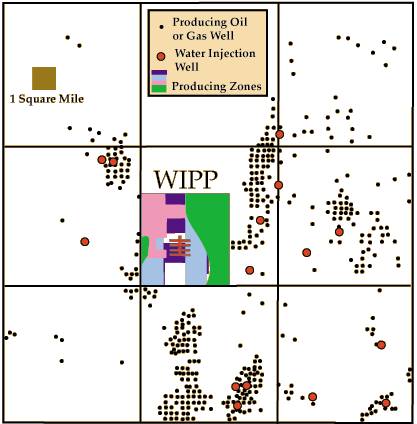
The Hartman Scenario
In 1991 an oil operator in southeastern New Mexico, named Hartman, drilled a hole into the Salado salt beds to about the same depth as the WIPP repository. So much water flooded into his well that he could drill no farther. Hartman abandoned the hole, lost a lot of money, and sued Texaco for damages. Texaco, it seems, had injected water into wells located about two miles from Hartman's failed borehole. The Texaco waterflood, injected under high pressure, had fractured beds of anhydrite and the water flowed laterally for a great distance.
By some chance, a highly respected and internationally known hydrologist learned of Hartman's lawsuit. This same hydrologist had been a member of NAS WIPP panel and knew a great deal about geologic and hydrologic conditions at WIPP. He recognized that if something like the Hartman episode happened it WIPP, water could flood the repository and change some of the best-case assumptions about the performance of WIPP. If no oil and gas wells were near the WIPP site there would be no chance of flooding. But producing oil wells, some within two miles, surround WIPP. About half of the fluid that is pumped from a producing well is brine that must be put back in underground. Some wells near WIPP were already injecting brine (see map).

The curious hydrologist ran modeling experiments and in 1997 he prepared a 47-page report for the Attorney General of New Mexico. The Hartman scenario is aggravated by the overpressure condition at WIPP which allows the pumped brine to flood the repository. The hydrologist's calculations show that enough contaminated brine escapes from the site to release 50 EPA units of radioactive contaminant. Escape of a single EPA unit violates WIPP certification criteria. How does DOE and EPA plan to deal with the Hartman scenario? Their short-term solution is to limit water injection near the site boundary. What is their long-term, 10,000-year or 240,000-year solution? They have none. Their "best case" would probably be to totally abandon petroleum as a source of energy, plastics, lubrication, etc.
PREVIOUS PAGE............NEXT PAGE